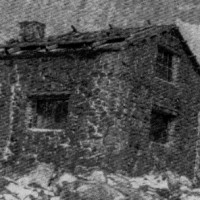While not rock climbing related per se, the Hull Cook journals being featured lately on Colorado Mojo are pretty fascinating reads.
The journals were written by Hull Cook about his experiences in the 1930’s working at the Boulderfield Shelter Cabin in the Boulderfield beneath Longs Peak, a well-known 14,259 ft. peak near Estes Park, CO:
During the late 1920s and early ’30s, a small hut stood at the Boulderfield on Longs Peak, at about 12,750 feet. Guests could hike or ride horseback to the Boulderfield Shelter Cabin, spend the night in relative comfort with bunks and hot meals, and climb the 14,259-foot peak in the morning, usually by the north face, which was equipped in those days with steel cables for hand rails. For two or three years during the early ’30s, Hull Cook worked at the Boulderfield Shelter Cabin, and his feats as a guide and rescuer have become legendary. Now, thanks to his son, Hull “Cactus” Cook from Bellingham, Washington, we are able to bring you Cook’s first-person, never-published tales.
The first installment takes you on a tour of the Boulderfield Shelter Cabin:
“Hooray, the Boulderfield at last! Level ground for a change.” That was the average climber’s reaction as he topped the final rounded rise of ground, high above Granite Pass, and beheld the nearly square-mile basin of jumbled rock that was the Boulderfield. He could now enjoy an unobstructed view of the famous Keyhole and the entire North Face. He was more than 12,000 feet above sea level. But where was the hotel? Then someone would see the distant small cube of granite masonry that was the Boulderfield Shelter Cabin.
“Don’t tell me that’s the hotel! That cracker box surely can’t be a hotel!” But it was.
The second installment discusses some of the difficulties one encounters when trying to build and maintain a structure six miles up a high altitude trail:
The Boulderfield Hotel, or shelter, or cabin, whatever you may call it, was constructed in 1926 and 1927 by the National Park Service, and was operated during its 10-year existence by the Colliers. The construction was not an easy task.
buy avanafil online https://marjukarin.ee/wp-content/languages/wpml/missing/new/avanafil.html no prescription
Everything but the actual rock had to be laboriously packed in on horses or mules over a very rough and rocky six-mile trail at high altitude. I believe Jack Moomaw, an early park ranger and guide, supervised the construction of the trail across the Boulderfield to the hotel site, which enabled pack mules and horses to negotiate this jumble of rocks without suffering broken legs. The workmen stayed at Timberline Cabin, so a good part of their day was spent in hiking the three miles each way to and from Boulderfield.
buy singulair online https://marjukarin.ee/wp-content/languages/wpml/missing/new/singulair.html no prescription
And the third installment delves into the youthful side of spending summers working at the cabin:
After the brief but heavy afternoon rain showers that are frequent in the mountains, we would often reach the cabin drenched, and wish to change into dry clothes, only to find the place crowded with tourists seeking shelter. My wife believes that this is where I lost my modesty, because we boys changed to dry clothes, crowds or not. We would step to a corner of the room, and while facing away from the people, we would peel down to the bare facts and dry off. Women showed surprise, shock, and embarrassment until, seemingly reassured by our confident composure, their discomfort was usually converted to amusement.
Take a few minutes to pore over these stories then try to imagine how much life has changed in our parks over the years.
buy xifaxan online https://marjukarin.ee/wp-content/languages/wpml/missing/new/xifaxan.html no prescription
Here in Wisconsin for example I’m captivated every time I look at the old pictures of what Devil’s Lake State Park used to look like. It’s almost hard to believe that the park, at some point, was home to a 9-hole golf course, a military barracks, a large water slide and a hotel of sorts. The park as it exists today may be better suited for conservancy, but it sure is a lot more boring than it once was!
Look for future installments in the Hull Cook Journals roughly once a week at Colorado Mojo.





Thanks for the nice mention of the remarkable Hull Cook stories. Just so people know, some of the best stories (1930s climbing on the East Face, rescues, and a New Year’s ascent of Longs) are still to come!
loading...
I really appreciated this piece. I like historical notes on climbing destinations.
loading...
Thank you for your kind support of Mr MacDonald’s blog wherein he has been publishing a few chapters of my father’s wee book about his days on the Boulderfield. I would like to make one small correction, my father actually put these stories on paper when in his late eighties and not when the events unfolded in the 1930’s.
My father was fortunate to live a long and happy life, however those of us fortunate enough to share some of those years with him have no doubt that the Boulderfield years were the best of times.
Best wishes,
HAC
loading...